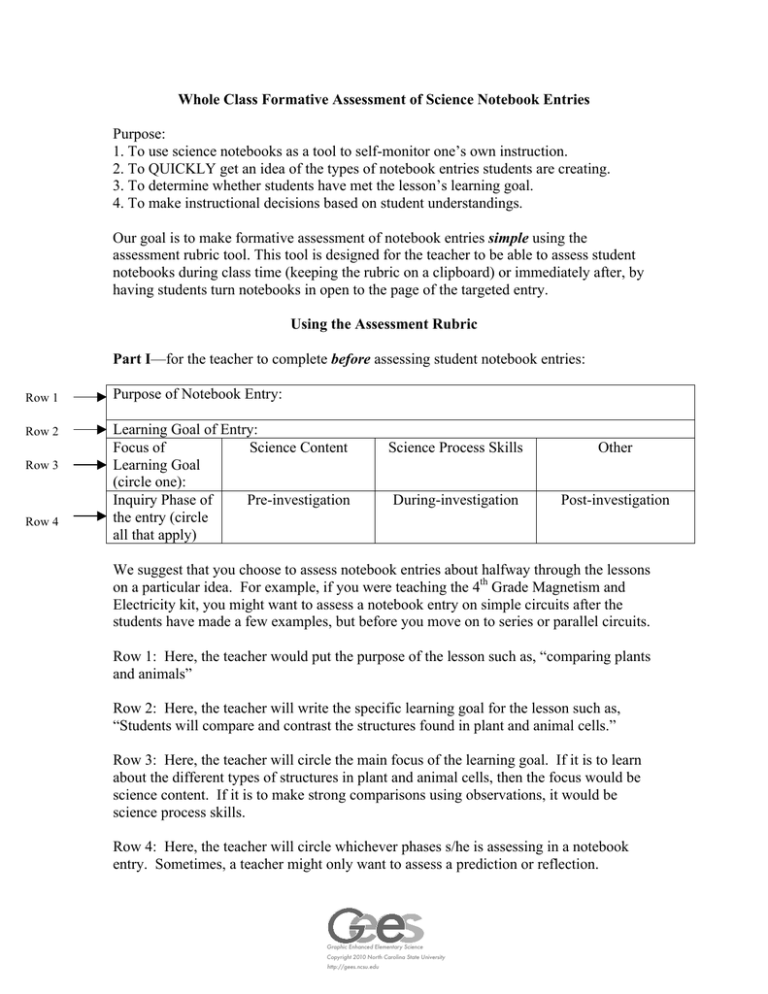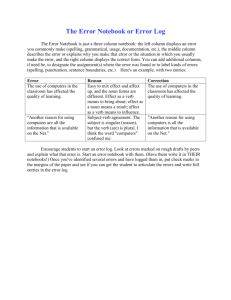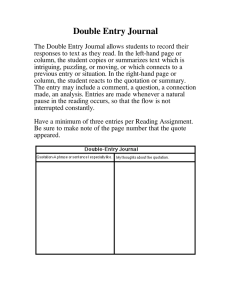Whole Class Formative Assessment of Science Notebook Entries
advertisement

Whole Class Formative Assessment of Science Notebook Entries Purpose: 1. To use science notebooks as a tool to self-monitor one’s own instruction. 2. To QUICKLY get an idea of the types of notebook entries students are creating. 3. To determine whether students have met the lesson’s learning goal. 4. To make instructional decisions based on student understandings. Our goal is to make formative assessment of notebook entries simple using the assessment rubric tool. This tool is designed for the teacher to be able to assess student notebooks during class time (keeping the rubric on a clipboard) or immediately after, by having students turn notebooks in open to the page of the targeted entry. Using the Assessment Rubric Part I—for the teacher to complete before assessing student notebook entries: Row 1 Purpose of Notebook Entry: Row 2 Learning Goal of Entry: Focus of Science Content Learning Goal (circle one): Inquiry Phase of Pre-investigation the entry (circle all that apply) Row 3 Row 4 Science Process Skills Other During-investigation Post-investigation We suggest that you choose to assess notebook entries about halfway through the lessons on a particular idea. For example, if you were teaching the 4th Grade Magnetism and Electricity kit, you might want to assess a notebook entry on simple circuits after the students have made a few examples, but before you move on to series or parallel circuits. Row 1: Here, the teacher would put the purpose of the lesson such as, “comparing plants and animals” Row 2: Here, the teacher will write the specific learning goal for the lesson such as, “Students will compare and contrast the structures found in plant and animal cells.” Row 3: Here, the teacher will circle the main focus of the learning goal. If it is to learn about the different types of structures in plant and animal cells, then the focus would be science content. If it is to make strong comparisons using observations, it would be science process skills. Row 4: Here, the teacher will circle whichever phases s/he is assessing in a notebook entry. Sometimes, a teacher might only want to assess a prediction or reflection. G es Graphic Enhanced Elementary Science Copyright 2010 North Carolina State University http://gees.ncsu.edu Part II—for the teacher to complete while assessing notebooks Description of Entry Content Format of Entry Driving Force of Entry In each column that applies, indicate the entry includes G=graphics, T=text, S=spatially organized text In each column that applies, indicate the driver of the element (T=teacher, S=student, B=balanced) Evaluation of Entries Completeness Evidence of of entry meeting learning goal (M=missing, P=Partial, A=Adequate) (0=no evidence, 1=does not meet goal, 2=Adequately meets goal) Student A Student B Student C Student D Column 1 Column 2 Column 3 Column 4 Column 5 Column 1: Lists student names (use as many rows as there are students). Columns 2 and 3: These provide information for the teacher on the format and driving force of notebook entries. In Column 2, the teacher lists any elements that appear in the entry: G= graphics (such as pictures or drawings), T= text (writing or numbers), or S=spatially organized text (tables, Venn Diagrams, charts, etc.). In column 3, the teacher lists the driving force of the entry: T=teacher (student copied exactly what the teacher said or wrote), S=student (student’s entry was completely his/her own), or B=balanced (contains teacher and student directed elements). Columns 4 and 5: these provide information for both the teacher and student evaluating the entry. In column 4, the teacher marks the completeness of the entry: M=missing, P=partial, A=adequate. In column 5, the teacher marks whether the student provides evidence for meeting the specific learning goal stated in Row 2: 0=no evidence, 1= does not meet goal, 2=adequately meets goal. This information can help the teacher to see how well students are recording the events that occurred in the classroom and whether students understand the learning goal of the lesson. Teachers can make future instructional decisions based upon whether or not students in the class met the learning goal. It is important to note that it is not necessary to mark a difference between “adequate” and “superior” entries for this purpose. G es Graphic Enhanced Elementary Science Copyright 2010 North Carolina State University http://gees.ncsu.edu


